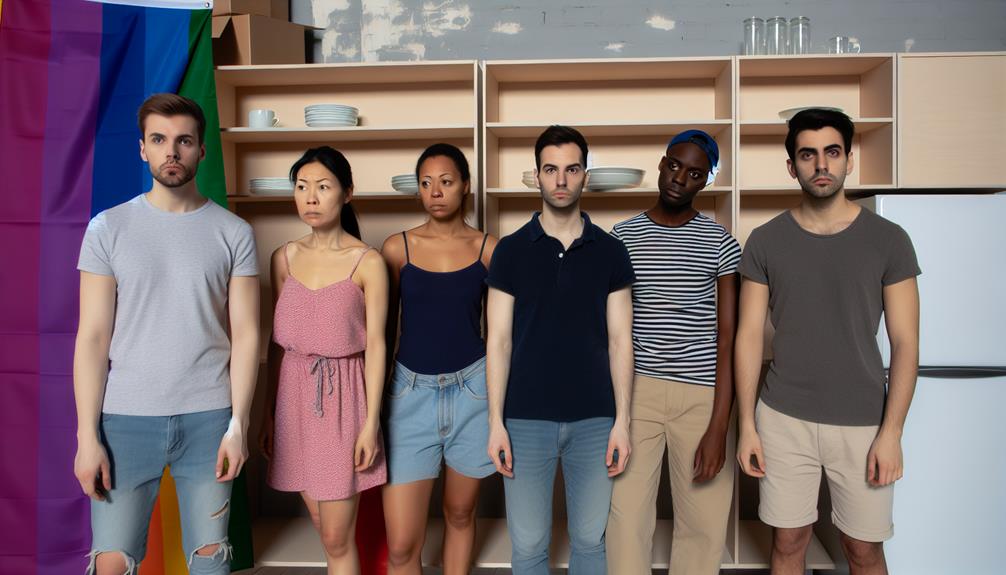Why Are LGBTQ Youth More Vulnerable to Food Insecurity?


Table of Contents
ToggleDid you know that 22% of LGBTQ youth live below the poverty line? This shocking statistic highlights how vulnerable they are to food insecurity. Many face societal stigma and discrimination, leading to unsafe environments where they might avoid school cafeterias and food pantries. Family rejection often results in homelessness and a lack of financial support. When you add in the challenges of unstable living conditions and racial disparities, the picture becomes even more complex. So, why exactly do these factors create such a pressing issue for LGBTQ youth?
Societal stigma and discrimination against LGBTQ youth often drive them to unstable living conditions, increasing their risk of food insecurity. When you face bullying or exclusion at school, it’s harder to feel safe and access basic needs like food. About 32.2% of LGBTQ students avoid school cafeterias because of safety concerns. This means many miss out on meals that are vital for their health and well-being.
Discrimination doesn’t just happen at school; it extends to other areas of life too. When you go to food pantries or charitable organizations and feel unwelcome, it discourages you from seeking help. This societal stigma makes it tough to find reliable sources of nutrition.
Legislative actions in some states also reflect this discrimination by attempting to deny free school lunches to LGBTQ students. These policies further limit your access to food, creating more barriers in an already challenging situation.
This constant struggle with societal stigma and discrimination greatly contributes to the food insecurity that many LGBTQ youth face. It’s not just about lacking food; it’s about being put in situations where getting enough to eat becomes a daily battle.
When facing societal stigma isn’t enough, many LGBTQ youth also endure rejection and alienation from their own families, further deepening their struggles with food insecurity. Family rejection can have severe consequences. Imagine coming out to your parents only to be met with hostility or even being thrown out of your home. This lack of acceptance leaves many LGBTQ youth without a stable support system, increasing their economic instability.
Without family support, securing basic needs like food becomes a daily struggle. You might find yourself unable to afford groceries or hesitant to use support resources due to the fear of further discrimination. This rejection not only impacts your mental health but also limits your ability to find stable employment, making food insecurity an ongoing issue.
Moreover, it’s not just about losing a home; it’s about losing the emotional and financial safety net that families usually provide. Studies show that over 70% of low-income LGBTQ individuals experienced childhood poverty, often tied to family rejection. This cycle of disadvantage makes it incredibly difficult to break free and secure a stable, food-secure future.

Facing unstable living situations, LGBTQ youth often find themselves struggling with food insecurity as a direct result of family rejection and lack of safe housing options. When you’re rejected by your family, finding a stable place to live can become a constant challenge. Many LGBTQ youth choose homelessness over staying in unaccepting home environments. This lack of a stable home leads to inadequate access to food.
Without a permanent address, it becomes tough to find consistent meals. Approximately 13.9% of LGBTQ youth between 18-24 experience food insufficiency. This means nearly one in seven are unsure where their next meal will come from. Economic instability from these unstable living situations further complicates things. Over 16.6% of LGBTQ youth report difficulty paying household expenses, making it even harder to secure enough food.
Safety concerns also play a role. Over 22.2% of LGBTQ youth avoid school cafeterias because they don’t feel safe, leading to missed meals. The lack of supportive housing options means many LGBTQ youth don’t have stable resources to guarantee they get adequate nutrition. These factors together create a challenging environment where food insecurity becomes a daily struggle.
LGBTQ youth often struggle to afford basic necessities like food due to higher rates of poverty and limited financial support from their families. When you’re not receiving any financial help from home, it can be incredibly tough to make ends meet. Many LGBTQ youth find themselves in this situation due to rejection upon coming out. This lack of support means they’re more likely to face food insecurity.
Let’s break it down further:
| Issue | LGBTQ Youth | Non-LGBTQ Peers |
|---|---|---|
| Poverty Rate | 22% | 11% |
| Food Insufficiency (ages 18-24) | 13.9% | Lower Rate |
| Insufficient Funds for Food (Specific Groups) | Up to 42% | Lower Rate |
Without adequate financial resources, many are forced to choose between paying rent and buying food. The intersection of underemployment and wage disparities means that LGBTQ youth often have less money to spend on necessities. For example, 31% of LGBTQ women and 42% of African-American LGBTQ individuals report not having enough funds for food. This financial instability leads to higher rates of food insufficiency, making it challenging to maintain a healthy diet.

Experiencing higher rates of poverty than their non-LGBTQ peers, many LGBTQ youth struggle to meet their basic needs. This financial instability directly contributes to food insecurity, making it hard for these young individuals to access nutritious food regularly.
Here are some essential points to understand:
Understanding these factors helps explain why LGBTQ youth face higher rates of poverty and food insecurity. By addressing these economic disparities, we can work towards creating a more supportive environment for all young people.
When considering the intersectional challenges, it’s crucial to recognize how diverse identities like race, socioeconomic status, and sexual orientation combine to intensify food insecurity for LGBTQ youth. These overlapping issues create a cycle of disadvantage that makes accessing meals even harder.
For example, racial disparities mean that an African-American LGBTQ youth faces more obstacles than their white counterparts. Economic disparities also play a huge role, as many LGBTQ youth come from low-income families or end up homeless due to family rejection. When you add the stress of bullying and discrimination, it’s no wonder these young people struggle to find reliable sources of food.
Here’s a breakdown to evoke the emotional weight of these challenges:
| Challenge | Impact | Emotion Evoked |
|---|---|---|
| Racial Disparities | Higher food insecurity rates | Frustration |
| Economic Disparities | Limited access to meals | Hopelessness |
| Family Rejection | Homelessness, unstable living | Loneliness |
These intersecting issues show how the struggle for food security isn’t just about poverty. It’s about the compounded difficulties that LGBTQ youth face every day. Understanding these layers can help us better support them and work toward real solutions.
LGBTQ youth are vulnerable due to societal stigma, discrimination, and often a lack of family support.
These challenges can lead to unstable living conditions and financial struggles. Many face higher rates of poverty and unemployment, making it harder to access basic needs.
Furthermore, feeling unsafe at school or home can further limit their access to resources.
This combination of factors creates a cycle of vulnerability for LGBTQ youth.
Imagine a fragile glass vase, easily shattered by the slightest impact. LGBTQ youth often find themselves in this delicate position, making them the most vulnerable to food insecurity.
They face societal stigma, discrimination, and often lack family support, leading to unstable lives. Economic struggles and unsafe school environments make it harder for them to access food, highlighting the urgent need for better support systems and resources.
You’re probably wondering which demographic group is most vulnerable to food insecurity.
Teens and young adults, especially those within the range of 18-24, face the highest risk.
They often struggle with unstable living conditions, limited financial resources, and higher rates of poverty and unemployment.
These challenges make it tough for them to consistently access nutritious food, leading to higher rates of food insecurity compared to other demographic groups.
Gender considerably affects food insecurity. Women, particularly LGBTQ women, often face higher rates of food insufficiency compared to men.
Societal discrimination, wage gaps, and underemployment hit women harder, making it tougher to afford food.
If you’re gender non-conforming, the challenges intensify due to societal stigma and rejection, leading to even less access to resources.
Imagine steering through a stormy sea without a compass. That’s what it’s like for LGBTQ youth facing food insecurity.
You see, societal stigma, family rejection, and unstable living conditions create waves that make it hard to stay afloat. Limited financial resources and higher poverty rates tie them down, while racial disparities add more weight.
To truly support these vulnerable youth, you’ve got to address these intertwined challenges and offer a lifeline of understanding and resources.
Originally posted 2024-07-31 11:38:06.
 Activism and ChangeDecember 10, 2025Tracing the Rainbow: The History of Pride Parades
Activism and ChangeDecember 10, 2025Tracing the Rainbow: The History of Pride Parades Featured PostsDecember 10, 2025Body, Boundaries, and Bliss: What Sex Taught Me About Being a Trans Woman
Featured PostsDecember 10, 2025Body, Boundaries, and Bliss: What Sex Taught Me About Being a Trans Woman Featured PostsNovember 30, 2025Why Are LGBTQ Youth More Vulnerable to Food Insecurity?
Featured PostsNovember 30, 2025Why Are LGBTQ Youth More Vulnerable to Food Insecurity? Featured PostsNovember 30, 2025A Lifetime of Longing: Tracking the Progression of Gender Dysphoria
Featured PostsNovember 30, 2025A Lifetime of Longing: Tracking the Progression of Gender Dysphoria